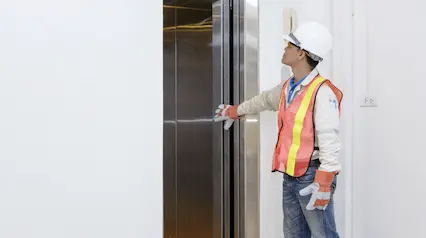Lift Maintenance Repair: Vital Services for Ideal Lift Efficiency
Wiki Article
Pro Tips for Maintaining Your Lift in Leading Problem: A Comprehensive Overview
Guaranteeing the optimal performance of a lift system is necessary for a effective and secure procedure in different settings, from industrial storage facilities to commercial structures. By adhering to an organized upkeep regimen and preemptively addressing possible problems, lift proprietors can reduce expensive downtime and security hazards.
Value of Routine Maintenance
Routine upkeep of your lift is essential to ensure its optimal efficiency and long life. By sticking to a routine upkeep routine, you can recognize and address possible problems before they intensify into expensive repair services or unanticipated downtime. Routine upkeep jobs such as lubricating moving parts, examining for damage, and examining hydraulic systems can assist prevent malfunctions and ensure safe procedure.Disregarding normal maintenance not only jeopardizes the effectiveness of your lift yet additionally presents safety threats to users and residential property. Components that are not appropriately kept may stop working all of a sudden, causing crashes or damage to the lift itself. Furthermore, resolving issues at an early stage with upkeep can expand the life-span of your lift and minimize the probability of significant break downs.
Along with enhancing security and efficiency, routine upkeep can additionally conserve you cash in the long run. By purchasing preventative maintenance steps, you can avoid pricey repairs or replacements that might emerge from overlooking the maintenance of your lift. On the whole, focusing on routine maintenance is crucial for making best use of the performance and long life of your lift system.
Top Components to Examine

Furthermore, pay very close attention to the lift's safety and security attributes, such as emergency quit buttons, safety and security sensors, and interlocking mechanisms, to ensure they are working appropriately. Regularly inspect the lift shaft for particles or blockages that could restrain the movement of the lift cars and truck. Last but not least, don't neglect to analyze the doors, hinges, and door drivers to guarantee smooth opening and closing procedures. By thoroughly checking these top elements, you can capture potential concerns early and guarantee your lift continues to be in leading problem.
Aggressive Troubleshooting Strategies
By tracking metrics such as lift speed, electric motor temperature level, and energy intake, maintenance teams can determine very early indicators of prospective concerns and take restorative activities before they intensify. In addition, carrying out a precautionary maintenance timetable that includes lubrication of relocating parts, testing of emergency situation brakes, and calibration of sensors can proactively address common lift system problems.Additionally, buying training programs for maintenance personnel on troubleshooting techniques specific to the lift design installed can equip them to detect and fix problems quickly. By remaining in advance of possible problems through positive troubleshooting, lift drivers can make certain a smoother and a lot more reliable procedure while decreasing the danger of unforeseen break downs.
Vital Lubrication Practices
Implementing correct lubrication practices is vital for guaranteeing the smooth procedure and long life of lift systems. Normal lubrication helps reduce rubbing in between relocating components, avoiding deterioration that can lead to pricey repair services and downtime. When it concerns raise upkeep, following a stringent lubrication routine is essential.Choosing the appropriate lubricating substance is the initial step in efficient maintenance. Various elements of the lift system may call for particular types of lubricants, such as oil or oil. Consult the manufacturer's standards to determine the ideal lubricating substances for each and every component.

Routinely evaluating the condition of moisturized parts is likewise important. Seek indicators of too much wear, contamination, or poor lubrication. Resolve any issues immediately to stop additional damages and ensure the ongoing smooth operation of your lift system. By prioritizing appropriate lubrication practices, you can prolong the life expectancy of your lift and maximize official source its efficiency.
Safety Steps for Lift Operators
In order to maintain a risk-free functioning setting and support operational efficiency, lift drivers need to rigorously stick to recommended safety and security methods, together with prioritizing crucial lubrication techniques for optimum lift efficiency. Security procedures for lift operators are essential to prevent crashes and ensure the smooth functioning of the lift system.In addition, lift operators have to prioritize personal safety tools (PPE) such as headgears, handwear covers, and safety belt when operating at heights or managing hefty tons. Clear interaction amongst drivers, maintenance specialists, and various other workers is important to avoid misunderstandings that might cause crashes. Lastly, drivers should remain vigilant, concentrated, and prevent disturbances while running the lift to ensure the safety of themselves and others in the vicinity.
Final Thought
To conclude, keeping a lift in leading problem is important for making certain security and effectiveness in operations. Routine maintenance, comprehensive evaluations of crucial parts, proactive troubleshooting, proper lubrication methods, and adherence to precaution are important for lengthening the life expectancy of the lift and preventing accidents. By following these guidelines, lift drivers can guarantee the ongoing functionality and safety and security of their devices.By adhering to a structured upkeep regimen and preemptively resolving possible issues, lift owners can reduce costly downtime and safety threats. Routinely inspect the lift shaft for debris or blockages that can hamper the motion of the lift automobile.In order to keep a secure functioning setting and maintain operational effectiveness, lift operators must rigorously stick to prescribed security methods, along with prioritizing crucial lubrication methods for ideal i loved this lift efficiency. Safety steps for lift operators are vital to prevent crashes and guarantee the smooth performance of the lift system. Regular maintenance, extensive evaluations of crucial elements, aggressive troubleshooting, correct lubrication methods, and adherence to safety and security actions are vital for prolonging the lifespan of the lift and protecting against accidents.
Report this wiki page